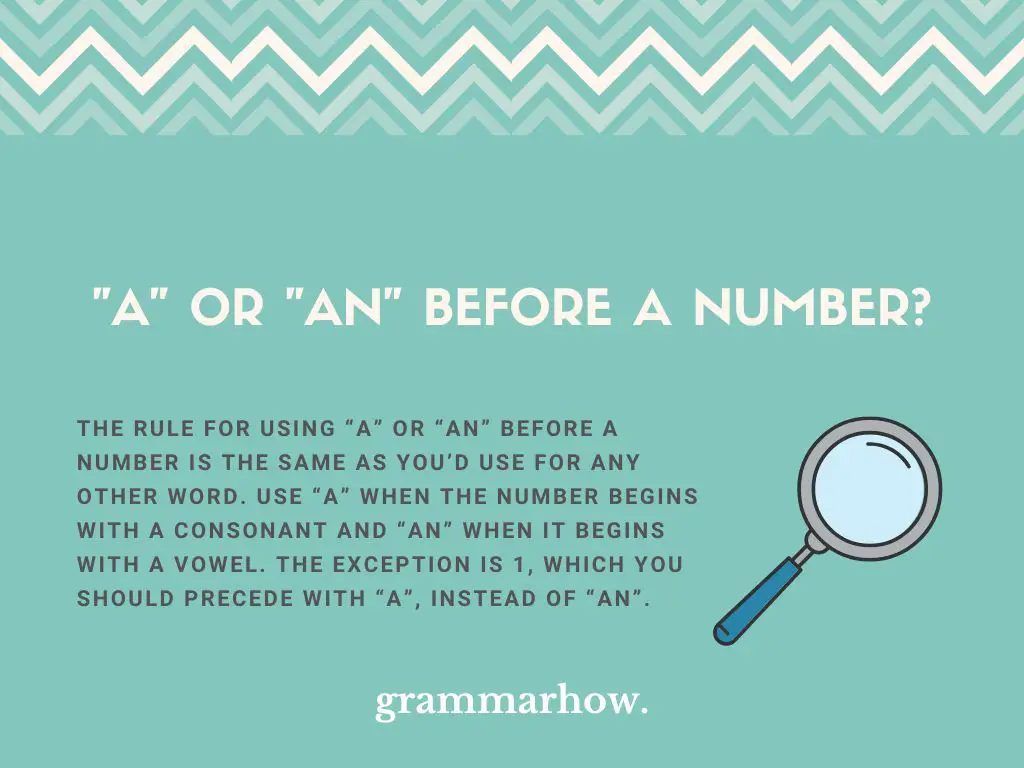What is the correct indefinite article to precede a number? Should we say “A” number or “An” number”?
This may be one of those things we just go about without giving too much thought to it. But we want to know, and we’ll take the time to find out.
“A” or “An” Before a Number?
The rule for using “A” or “An” before a number is the same as you’d use for any other word. Use “A” when the number begins with a consonant and “An” when it begins with a vowel. The exception is 1, which you should precede with “A”, instead of “An”.

Take look at some examples:
- Could you lend me a five dollars bill?
- Could you lend me an five dollars bill? (incorrect)
- Do you have an 11 in your game?
- Do you have a 11 in your game? (incorrect)
Regardless of having the number written as a word or just the number symbol, the rule remains always the same. Think about how the number sounds if you find yourself in a situation like the second sentence, and apply the indefinite article that makes more sense.
In the examples, you find two sets of sentences. One contains the correct indefinite article for that number, while the other presents the incorrect one. This way you can look and compare.
When to Use “A”
You should use “A” before a number every time the number begins with a consonant. If all you have is the symbol for that number (and not a full word written), think about how that number sounds, and apply the same rule.
Those are the most common numbers used with “A”:
- A thousand.
- A hundred.
- A one.
And those are some helpful examples that show “A” before a number in a sentence:
- I need a hundred dollars to complete this month’s rent.
- It costs nearly a thousand euros to go on that cruise.
- I just found a one-dollar bill on the ground.
- The study results showed about a 55% accuracy rate.
- Carol scored a 75% on the math portion of the test.
- Daniel is a 10, but Joanna doesn’t seem to realize that.
A number that begins with a consonant should always be preceded by the indefinite article “A”. It doesn’t matter if you have a 5 or the word five. Regardless of being just the symbol or the full word, the rule remains the same.
When to Use “An”
The indefinite article “An” should be used before any number that starts with a vowel (or that sounds like it). Regardless of having the full word or just the symbol, the rule remains the same.
Those are the most common numbers used with “An”:
- An eleven.
- An eighteen.
- An eight.
And those are some good examples of “An” preceding numbers in sentences:
- I just need an eleven to win!
- Do you have an eight on your cards?
- An eighteen-year-old was arrested concerning last week’s robberies.
- The forecast showed about an 85% chance of rain.
- Consuelo scored an 18% higher percentage on the test.
- An 11% drop in sales is expected after the news last night.
Is It “a 8” or “an 8”?
The rule for “8”, which starts with an “e”, is the same rule we have for any number that starts with a vowel. The correct indefinite article to accompany the number 8 is “An” and you should say “An 8” or “An Eight”.
Take a look at the examples below:
- Do you have a 8 on your cards? (incorrect)
- Do you have an 8 on your cards?
- The company expects a eight percent increase for this fiscal year. (incorrect)
- The company expects an eight percent increase for this fiscal year.
Following the rule, the correct indefinite article to accompany 8 is “An”. Keep that rule in mind and apply it to all numbers.
Final Thoughts
When deciding which indefinite article to use before a number, think about how that number sounds or which letter it begins with. Then follow the same rule you would use for any word: if it starts with a vowel, use “An”; if it starts with a consonant, use “A”.

Martin holds a Master’s degree in Finance and International Business. He has six years of experience in professional communication with clients, executives, and colleagues. Furthermore, he has teaching experience from Aarhus University. Martin has been featured as an expert in communication and teaching on Forbes and Shopify. Read more about Martin here.
